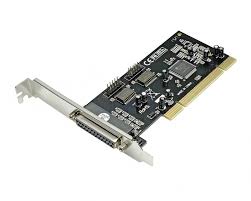A PCI parallel card is an expansion card designed to add parallel ports to a computer system. Here are some details about it:
- **Functionality:** The PCI parallel card allows you to connect parallel devices, such as printers, scanners, or external drives, to your computer.
- **Interface:** It typically utilizes the Peripheral Component Interconnect (PCI) interface to connect to the motherboard of the computer.
- **Compatibility:** These cards are compatible with a wide range of operating systems, including Windows, macOS, and Linux.
- **Ports:** A typical PCI parallel card provides one or more parallel ports, often in the form of DB25 or DB9 connectors.
- **Driver Installation:** Depending on the operating system, you may need to install drivers provided by the manufacturer to ensure proper functionality.
- **Usage:** PCI parallel cards are commonly used in situations where legacy parallel devices need to be connected to modern computers that lack built-in parallel ports.
- **Installation:** Installation involves inserting the card into an available PCI slot on the motherboard and securing it in place. After installation, the device typically appears as a standard parallel port in the operating system.
- **Benefits:** These cards provide a cost-effective solution for adding parallel connectivity to computers, allowing users to continue using older parallel devices with newer systems.
Overall, a PCI parallel card is a useful expansion option for users who require connectivity to legacy parallel devices.
